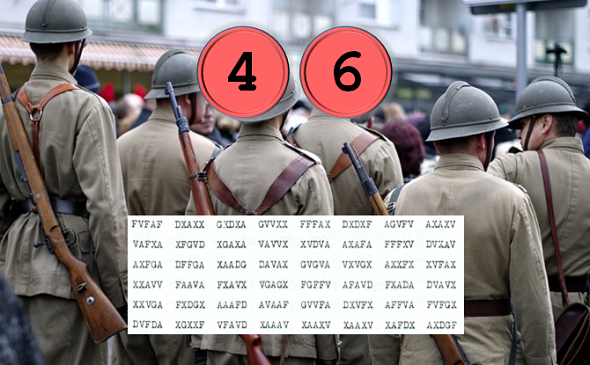ADFGVX is an encryption method used by the Germans in WW1. Some 20 ADFGVX radio messages from 1918 are still unsolved.
Click here for the complete top 50 list
In World War I cryptology plaid an important role. As cipher machines like the Enigma were still in its infancy, all nations involved in the war almost exclusively relied on manual cipher systems. Many of them proved laborious and insecure. The trouble virtually all WW1 armies had with their manual ciphers caused many engineers to invent encryption machines in the 1920s and 1930s. This resulted in the encryption technology of WW2 heavily relying on machines, which was a major improvement to WW1.
ADFGVX
In the last months of World War I, the German Army and diplomatic services used a manual cipher named ADFGVX to encrypt radio messages between Germany and its outposts and stations in the Balkans, the Black Sea, and in the Middle East. To use ADFGX one needs a table with 6×6 cells. The letters A, D, F, G, V and X mark the lines and the columns of this table (these letters were chosen because they can easily be distinguished from each other in their Morse code representations). The table is filled with the letters of the alphabet and the digits from 0 to 9. In the following example HOUSE is used as a key word to change the order of the alphabet:
A D F G V X A H O U S E A D B C D F G I F J K L M N P G Q R T V W X V Y Z 0 1 2 3 X 4 5 6 7 8 9
Every letter and digit is represented by a bigram indicating its line and column: H=AA, O=AD, U=AF, S=AG, …
The cleartext I HAVE A DREAM encrypts to: DX AA AX GG AV AX DF GD AV AX FG.
In the second encryption step, the order of the letters is changed using a columnar transposition. To do so a second key word, say ROBIN, is needed. The columns are read out in alphabetic order:
ROBIN ----- DXAAA XGGAV AXDFG DAVAX FG
As the B appears first in the alphabet, the B column is read out first: AGDV. It is followed by the I column (AAFA), the N column (AVGX), the O column (XGXAG) and the R column (DXADF). This results in the following ciphertext:
AGDV AAFA AVGX XGXAG DXADF
George Lasry’s decipherings
Hundreds of ADFXVX cryptograms from July to December 1918 were preserved by an US Officer named James Rives Childs. They appear in Childs’ treatise General Solution of the ADFGVX Cipher System, which was published as a book by Aegean Press Park in 2000.
Apparently, nobody was very much interested in these unsolved cryptograms until codebreaking expert George Lasry ran across them. George has solved many historical cryptograms in recent years. He is mentioned on Klausis Krypto Kolumne many times.
George is clearly the best codebreaker I know when it comes to deciphering cryptograms encrypted with a known algorithm (i.e., the challenge is to find the key). For instance, George has broken the Double Columnar Transposition (Doppelwürfel) challenge, which many thought was unbreakable.
It comes as no surprise that George was very successful in breaking the ADFGVX messages mentioned in Childs’ book. He recently published his results in a Cryptologia article co-written with Ingo Niebel, Nils Kopal and Arno Wacker. In this article, the four authors present a new computerized method for the ciphertext-only cryptanalysis of ADFGVX messages, which they developed for that purpose. They also provide details on how all the keys were recovered and almost all the messages decrypted, despite the low quality of significant parts of the intercepted material. As co-author Ingo Niebel is a historian, the article also analyzes the messages in their historical context.




Kommentare (56)